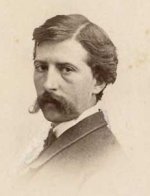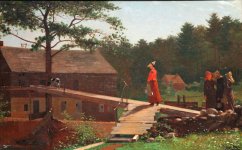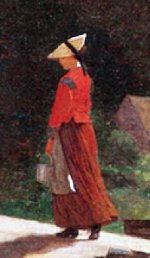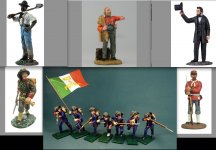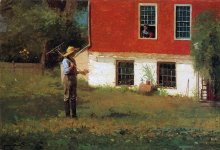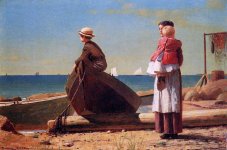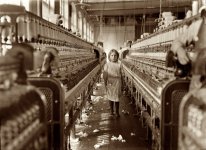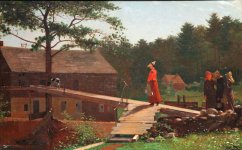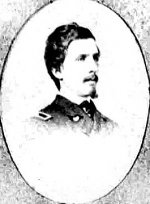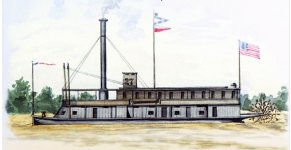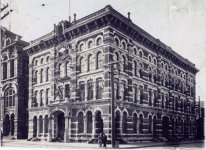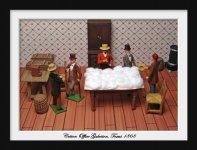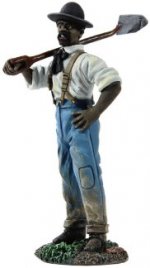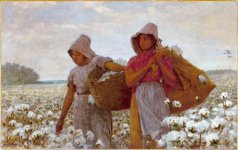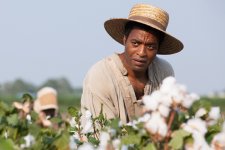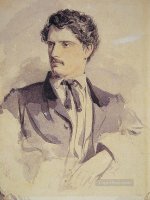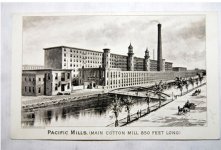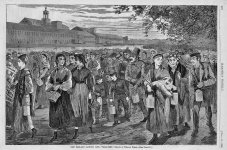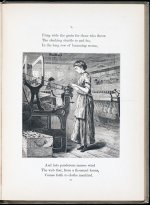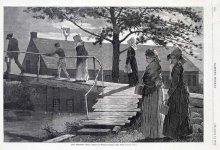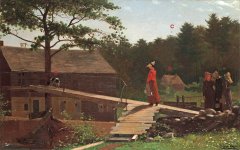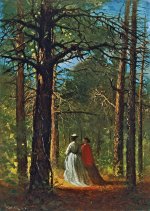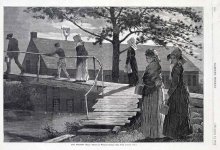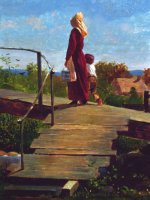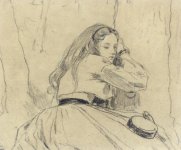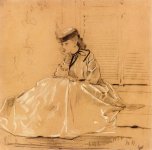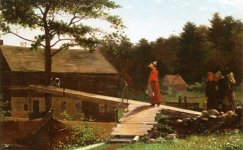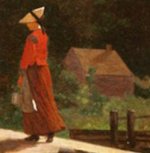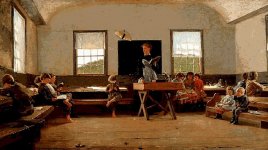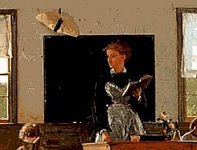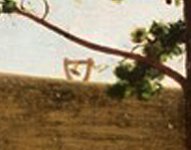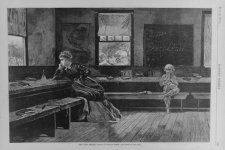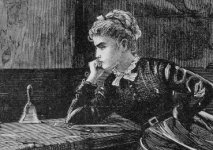PolarBear
Major
- Joined
- Feb 24, 2007
- Messages
- 6,706
In Memory of Shannon Reuss (1970-2015)
Part 1 8/17/16
I am by training an art historian. I am also a collector of toy soldiers many of which I have purchased from the nice folks at Treefrog Treasures. As an art historian, I am currently writing an essay about an American painting entitled The Old Mill. It was created in 1871 by Massachusetts born artist Winslow Homer (1836-1910). Those of you who collect Civil War figures may be familiar with the illustrations of that conflict that he did as a Special Artist for Harper's Weekly as well as his oil paintings on the subject. There have been two previous scholarly articles about The Old Mill. The first in the context of women working in the textile mills of New England and the second which identifies the main figure in the painting as a school teacher.My interpretation also looks at that figure but in a new way focusing on what she is wearing. The working title of my essay is "THE TASTE OF FREEDOM " : Winslow Homer and the Woman in the Red Jacket.
As I have worked on this project and been reading a wide variety of background material, it occurred to me that my subject is related to my toy soldier collecting. I thought this would be a great way to introduce this topic to an audience of fellow collectors. I realized that Treefrog Treasures is another form of resource to interpret and explain this very interesting work of art. Winslow Homer tried to avoid explaining what his paintings meant and let the works speak for themselves. However, he left a number of visual clues in his art works that provide art historians with a basis for interpretation. For me, the most important clue is the red jacket she is wearing. The garment is known as a "Garibaldi Jacket" named for the Italian patriot, soldier and revolutionary Giuseppe Garibaldi (1807-1882). It was very popular in the 1860s, especially during the American Civil War. Like the Zouave jacket it was a very popular fashion for women.
This thread will be an ongoing effort of exploring the painting in the context of the history and individuals of the time. I will add new installments as each is ready that will explain my interpretation which I hope will be of interest. In this first installment I have included a photograph of the artist taken in 1867, the painting itself, a detail of the woman in red, and a montage of toy soldiers from Treefrog Treasures that helped inspire this project.
Stay Tuned
Randy
Part 1 8/17/16
I am by training an art historian. I am also a collector of toy soldiers many of which I have purchased from the nice folks at Treefrog Treasures. As an art historian, I am currently writing an essay about an American painting entitled The Old Mill. It was created in 1871 by Massachusetts born artist Winslow Homer (1836-1910). Those of you who collect Civil War figures may be familiar with the illustrations of that conflict that he did as a Special Artist for Harper's Weekly as well as his oil paintings on the subject. There have been two previous scholarly articles about The Old Mill. The first in the context of women working in the textile mills of New England and the second which identifies the main figure in the painting as a school teacher.My interpretation also looks at that figure but in a new way focusing on what she is wearing. The working title of my essay is "THE TASTE OF FREEDOM " : Winslow Homer and the Woman in the Red Jacket.
As I have worked on this project and been reading a wide variety of background material, it occurred to me that my subject is related to my toy soldier collecting. I thought this would be a great way to introduce this topic to an audience of fellow collectors. I realized that Treefrog Treasures is another form of resource to interpret and explain this very interesting work of art. Winslow Homer tried to avoid explaining what his paintings meant and let the works speak for themselves. However, he left a number of visual clues in his art works that provide art historians with a basis for interpretation. For me, the most important clue is the red jacket she is wearing. The garment is known as a "Garibaldi Jacket" named for the Italian patriot, soldier and revolutionary Giuseppe Garibaldi (1807-1882). It was very popular in the 1860s, especially during the American Civil War. Like the Zouave jacket it was a very popular fashion for women.
This thread will be an ongoing effort of exploring the painting in the context of the history and individuals of the time. I will add new installments as each is ready that will explain my interpretation which I hope will be of interest. In this first installment I have included a photograph of the artist taken in 1867, the painting itself, a detail of the woman in red, and a montage of toy soldiers from Treefrog Treasures that helped inspire this project.
Stay Tuned
Randy


